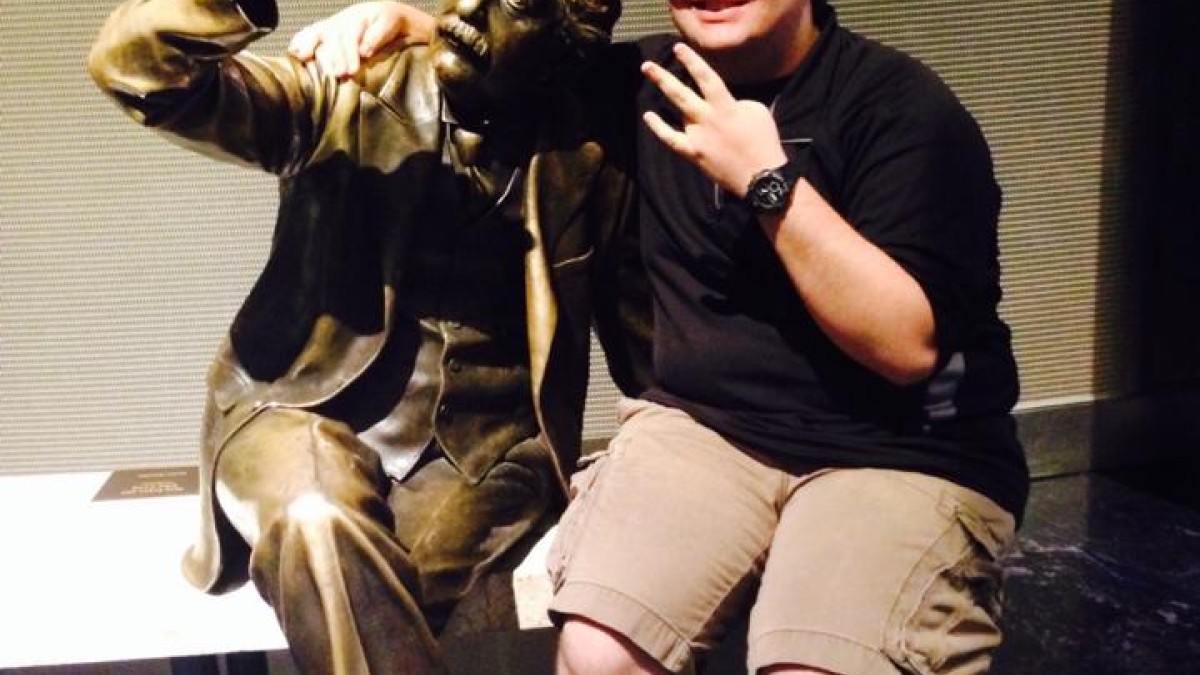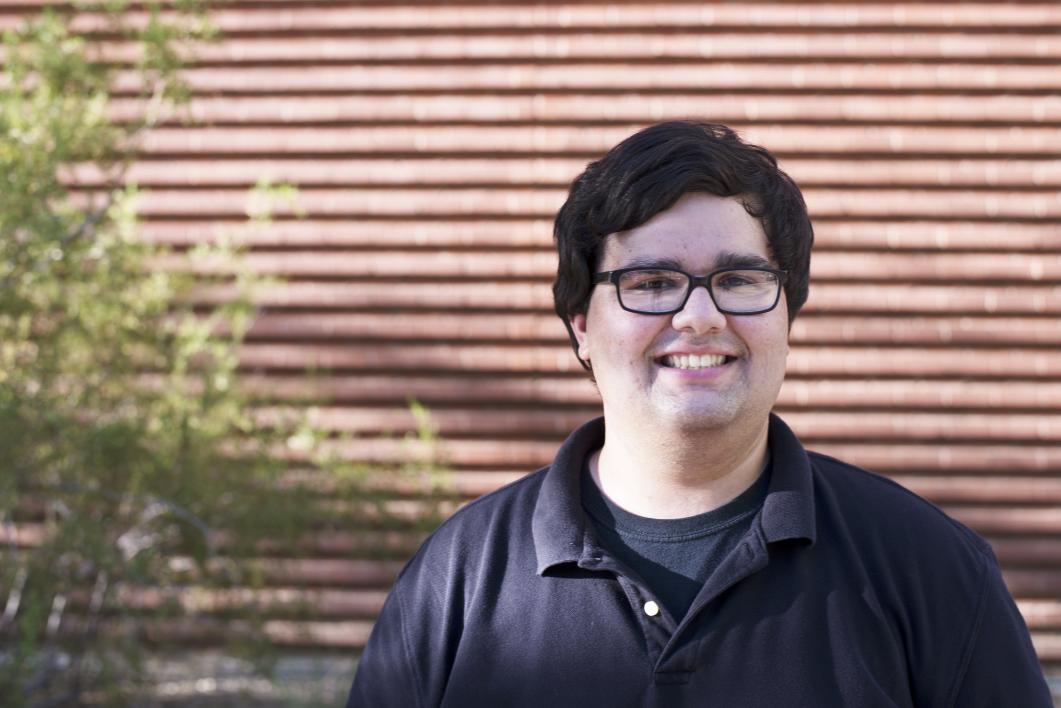ASU astronomy grad to see the world — and stars

Michael Busch at the Griffith Observatory (with Albert Einstein).
Editor's note: This is part of a series of profiles for spring 2016 commencement. See the rest here.
Michael Busch, who will be graduating this spring with a dual bachelor’s degree in astrophysics and physics, was recently awarded a National Science Foundation (NSF) graduate fellowship. Busch is also a recipient of the inaugural Origins Project Undergraduate Research Scholarship. He plans to attend Johns Hopkins University to pursue a doctorate in astrophysics.
His advice to current students? “Get involved in research and outreach as early as possible.”
As an undergrad, Busch joined the Geo Club, AstroDevils and Students for the Exploration and Development of Space (SEDS) in his first year and did outreach with all three groups. He is also a community mentor, a NASA Space Grant Fellow and part of the Low-Frequency Cosmology Group.
“Performing outreach is not only an essential part of science communication with the general public,” said Busch, “it gives students the opportunity to network, practice their presentation skills, and it’s just fun as well.”
His plans for the future include travelling to Germany to spend seven weeks at the University of Hamburg to use the Low-Frequency Array (LOFAR) to study clusters of radio galaxies. He then plans to start his doctorate at Johns Hopkins.
Although he is excited about this next step, he says he will “always be a Sun Devil at heart!”
Busch answered some questions about his experience at ASU:
Question: What was your “aha” moment, when you realized you wanted to study the field you majored in?
Answer: When I was 5 years old my family lived in Los Angeles, and my parents took me to Griffith Observatory. I did not understand much of the exhibits, but I was inspired enough to realize that this was something I wanted to study for the rest of my life, so when I got to college I knew exactly what I wanted to do.
Q: What’s something you learned while at ASU — in the classroom or otherwise — that surprised you, that changed your perspective?
A: As I visited other departments, I realized that ASU is probably the most diverse place I will have the opportunity to work at. ASU has the wonderful advantage of being a distinctly diverse oasis amongst the rest of the schools in our country. There are so many cultures and perspectives that merge at ASU. I had the opportunity to fill most of my electives with Woman and Gender Studies classes to study the barriers that exist not only for women, but minorities as well, especially in the STEM field. Although I wasn't exactly surprised, as a minority myself I simply became more aware of the situation and I now advocate greatly for diversity in STEM. Through three years as a NASA Space Grant fellow I have had the opportunity to conduct outreach not only at ASU but also to schools in the area, including the Salt River Pima-Maricopa Community.
Q: Why did you choose ASU?
A: I came to the conclusion that I would go to ASU when I was a freshman in high school while living in Casa Grande, Arizona. I was the president of our STEM club and led a group of students to ASU in 2008 to attend the first Origins Project Symposium where I saw Lawrence Krauss, Stephen Hawking and Neil deGrasse Tyson, among others. I enjoyed the event so much that I decided that I would go to ASU.
Q: What’s the best piece of advice you’d give to those still in school?
A: Get involved in research and outreach as early as possible, even in the freshman or sophomore years. In my case, I joined Geo Club, AstroDevils and SEDS my first year and did outreach with all three groups. Then I met Meg Hufford, the great SESE outreach coordinator, and she introduced me to professor Judd Bowman, for whom I would end up doing research for three years. Performing outreach is not only an essential part of science communication with the general public, it gives students the opportunity to network, practice their presentation skills, and it’s just fun as well. Additionally, any sort of NSF proposal in the future will ask for outreach and/or “broader impacts” of a proposal, so keeping in mind the outreach aspect of your research is imperative to long-term goals.
Another great piece of advice I can give to students: Don't stress so much about getting that 4.0; it does not matter. Once you get into graduate school, no one cares — at all — about your undergraduate GPA! Moreover, most of your actual skills that you will use in research are learned doing research as opposed to in your classes. It is much better to be focused on keeping your stress in check and having a healthy routine that includes exercise.
Q: What was your favorite spot on campus, whether for studying, meeting friends or just thinking about life?
A: Although associated with many late nights of studying and homework, I would have to admit the PSF Physics and SESE Tutoring Center is my favorite place because of the sheer amount of time I spent in there during my degree. It is also the place I usually go to meet up with my friends before or after class. Aside from that, one of my favorite things to do is walk around campus, and in particular, Palm Walk on a breezy Sunday when there's no one around.
Q: What are your plans after graduation?
A: In the summer I will be travelling to Germany to spend seven weeks at the University of Hamburg to use the Low-Frequency Array (LOFAR) to study clusters of radio galaxies, then I will be starting my PhD at Johns Hopkins. While in graduate school I plan on joining the Johns Hopkins Symphony as a cellist, go kayaking on Chesapeake Bay and complete a wine-tasting tour of the USA.
Q: If someone gave you $40 million to solve one problem on our planet, what would you tackle?
A: I would have a hard time choosing one cause, but as a community mentor for the College of Liberal Arts and Sciences for three years I have become an advocate for suicide prevention and sexual-assault awareness on college campuses. Having had to sometimes help students that go through such traumatic events really opened my eyes to the struggles that students face that are seldom talked about. Aside from that, one of my role models is Malala Yousafzai, the Nobel Peace Prize winner who stood up to the Taliban and advocates for education for all girls and children around the world. If I had the chance to collaborate with her in order to spread access to education for children everywhere I would definitely do that.
More Science and technology

Beyond the 'Dragon Arc': Unveiling a treasure trove of hidden stars
NASA's James Webb Space Telescope (JWST) has set a new milestone: capturing images of over 40 individual stars in a galaxy so…

ASU selected as home and partner for CHIPS and Science Act-funded national facility for semiconductor advanced packaging
Following a week where a spirited effort by the Sun Devil football team captured the nation’s attention in the Peach Bowl, it is…

ASU professor shares the science behind making successful New Year's resolutions
Making New Year’s resolutions is easy. Executing them? Not so much.But what if we're going about it all wrong? Does real change…


